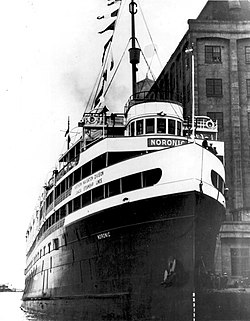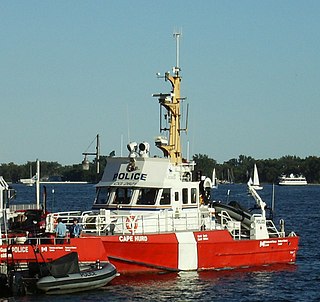
Duwamish was one of the most powerful fireboats in the United States several times over her 75-year working life. She is the second oldest vessel designed to fight fires in the US, after Edward M. Cotter, in Buffalo, New York.

A fireboat is a specialized watercraft with pumps and nozzles designed for fighting shoreline and shipboard fires. The first fireboats, dating to the late 18th century, were tugboats, retrofitted with firefighting equipment. Older designs derived from tugboats and modern fireboats more closely resembling seafaring ships can both be found in service today. Some departments would give their multi-purpose craft the title of "fireboat" also.

Ned Hanlan is a steam-powered tugboat that operated in Toronto Harbour in Toronto, Ontario, Canada. The tugboat entered service in 1932 and was retired in 1967. She was then put on display at Exhibition Place. She was moved in 2012 to Hanlan's Point on the Toronto Islands; she is named after champion rower Ned Hanlan.

SS Noronic was a passenger ship that was destroyed by fire in Toronto Harbour in September 1949 with the loss of at least 118 lives.

Toronto Fire Services (TFS) provides fire protection, technical rescue services, hazardous materials response, and first responder emergency medical assistance in Toronto, Ontario, Canada. Toronto Fire Services is currently the largest municipal fire department in Canada.

Edward M. Cotter is a fireboat in use by the Buffalo Fire Department at Buffalo, New York, United States. Originally named William S. Grattan, she was built in 1900 by the Crescent Shipyard of Elizabeth Port, New Jersey. Due to age she was rebuilt in 1953 and renamed Firefighter upon her return to service. The following year she was renamed Edward M. Cotter. Her namesake, Edward Cotter, was a Buffalo firefighter and leader of the local firefighters union who had recently died.

William Lyon Mackenzie, built by Russel Brothers, named for Toronto's first mayor William Lyon Mackenzie, is a fireboat for the Toronto Fire Services (TFS). It was built in 1964 with a modified Tugboat hull to provide marine fire fighting as well as icebreaking capabilities. In 2004 the fireboat was refurbished and it is expected to be in service until 2037.

The Ville-class harbour tugboats are a class of tugboats employed by the Royal Canadian Navy.

The Glen-class tug is a class of naval tugboat operated by the Royal Canadian Navy. Constructed in Canada, the class entered service between 1975 and 1977. The five vessels that comprise the class are split between the two major naval bases of the Royal Canadian Navy. The Royal Canadian Navy operated a fleet of tugboats during the Second World War which were also named the Glen class. The vessels of the current Glen class are each named after one of the vessels of the earlier class.

CFAV Firebrand is a Fire-class fireboat in the Royal Canadian Navy designed by Robert Allan Ltd.. Firebrand is based in CFB Esquimalt, on Vancouver Island. Her sister ship CFAV Firebird was based in CFB Halifax and decommissioned in 2014.

CFAV Firebird is a Fire-class fireboat in the Royal Canadian Navy designed by Robert Allan Ltd.. Firebird is based in CFB Halifax, in Halifax, Nova Scotia. Her sister ship CFAV Firebrand is based in CFB Esquimalt.

Baltimore is a preserved steam-powered tugboat, built in 1906 by the Skinner Shipbuilding Company of Baltimore, Maryland. She is formerly the oldest operating steam tugboat in the United States, but at present does not hold an operating license issued by the US Coast Guard, so is unable to leave her dock at the Baltimore Museum of Industry on Key Highway, Baltimore. Her hull is not capable of operating on open water. Baltimore was built and operated as a harbor inspection tug, capable of acting as a municipal tugboat for city barges, as well as an official welcoming vessel and VIP launch, an auxiliary fireboat, and as a light icebreaker.

Pyronaut is a specialised form of fireboat known as a fire-float. It was built in 1934 by Charles Hill & Sons Ltd., Albion Dock Bristol, Yard No. 208. Registered number 333833. She is owned by Bristol Museums and based at M Shed in Bristol's Floating Harbour.

The Narara was a wooden carvel screw steamer built in 1900 at Jervis Bay, that was wrecked when it sprang a leak while carrying general cargo between Sydney and the Hawkesbury River and was lost at 2 ml SE off Little Reef Newport near, Barranjoey, New South Wales on 29 May 1909. The vessel commenced her runs from Sydney Harbour to the Hawkesbury River in January 1900 and continued on this run till the time of her final 1909 sinking. During 1903 the vessel was burned to the water line and sank at its mooring only to be refloated and rebuilt and started back on the same run.

The William Rest was a tugboat built for the Toronto Harbour Commission in 1961 for $150,000 CAD. She was built in Erieau, Ontario by the Erieau Shipbuilding and Drydock Limited. She displaced 61 gross tons. She was named after the commission's recently deceased director of planning. Rest had worked for the Commission for 46 years.

The T.J. Clark was a fireboat, ferry and cargo vessel, that was operated in the city of Toronto, Ontario, Canada from 1911 to 1959. She was powered by a pair of steam engines manufactured by Polson Iron Works.

At least six Fireboats in Toronto have helped protect the city's waterfront and maritime commerce.

The Iron Guppy is a tugboat, built in 2016, and owned and operated by Ports Toronto. She replaced the William Rest, a tugboat that served in Ports Toronto, and its predecessor agencies, since 1961. The Iron Guppy has very similar operational characteristics as the William Rest, however, with modern electronics.

CCGS Cape Hurd is a 21.4-metre (70 ft) mid-shore patrol vessel formerly serving with the Canadian Coast Guard and last stationed in Sarnia, Ontario. The vessel is classed for inland waters with no ice-class. It now serves as a fireboat in Toronto.

Although it is a busy port, there is sparse record of fireboats in Halifax, Nova Scotia.



















